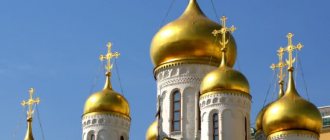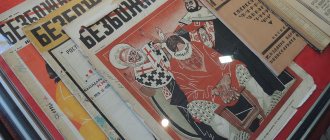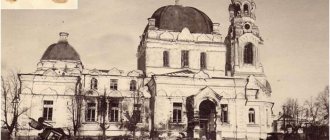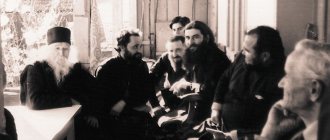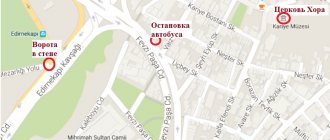Chapter II. RUSSIAN ORTHODOX CHURCH IN THE 18TH CENTURY
In the manifesto of Catherine II of July 28, 1762, which was compiled by Archbishop Dimitri (Sechenov), the removal of Peter III was explained, first of all, by the fact that during his reign a threat loomed over the Orthodox Church. “It was clearly revealed to all direct sons of the Russian Fatherland what a danger to the entire Russian state began with the very act, namely: our Greek Orthodox law first of all felt its shock and the destruction of its church traditions, so that our Greek Church was already extremely exposed, remained the last of its dangers of change ancient Orthodoxy in Russia and the adoption of a heterodox law.”
Catherine loved to present herself as a faithful daughter of the Church, a defender of Orthodoxy. In fact, however, the empress, a Lutheran by birth, who easily, but hardly out of inner conviction, converted to Orthodoxy, was not a religious person. She adhered to the deistic views common in Europe during the Age of Enlightenment. Catherine corresponded with Voltaire, Diderot, and D'Alembert. But she did not share, at least in words, the extreme views that these philosophers reached. She wrote to the atheist Diderot: “I am glad that I belong to the number of madmen who believe in God.”
And yet, Catherine’s contemporary historian Prince M.M. Shcherbatov allowed himself to doubt this. He wrote: “Does she have faith in the Law of God? For if she had this, then the very Law of God could correct her heart and guide her steps on the path of truth. But no! Intoxicated by mindless reading of new writers. The Christian law (although she pretends to be quite devout) is not respected for anything.”
The basis of her views on the relationship between the Church and the state was an acute hostility to the Catholic doctrine of the “two swords”, to any clericalism, of which she, completely in vain, suspected the Orthodox clergy. The religious fanaticism that she found in any manifestation of religious zeal frightened and repelled her. Catherine adhered to the principles of broad religious tolerance, reaching the point of complete indifference. As a statesman, she is well characterized by one remark she made before her accession to the throne: “Respect faith, but not allow it to influence state affairs.”
A skillful and subtle politician, she did not immediately reveal her intentions towards the Church. Two weeks after her accession, the Senate issued a decree on the return of land holdings that had previously belonged to diocesan houses, monasteries and church clergy. But the joy of the clergy on this occasion turned out to be premature. Another three weeks passed, and a manifesto was issued, which declared the government’s intention to reconsider the issue of church estates: “We have no intention or desire to appropriate church estates for ourselves, only we have the power given to us by God to prescribe laws on their best use for the glory of God and benefit of the Fatherland. And for this, under the protection of God, we intend to bring to perfection the establishment of the entire spiritual staff, similar to the church laws that our most kind grandfather, Emperor Peter the Great, followed, by establishing for this purpose a special commission of ecclesiastical and secular persons under our own jurisdiction.”
The Commission included the President of the Synod, His Eminence Dmitry (Sechenov), elevated to the rank of Metropolitan, Archbishop of St. Petersburg Gabriel (Kremenetsky), Bishop of Pereyaslavl Sylvester, as well as Chief Prosecutor Prince A. Kozlovsky, Prince A.B. Kurakin, Prince S. Gagarin, Count I.I. Vorontsov, and G. Teplov. The result of the work of this commission was the famous Church Decree on Church Estates, issued on February 26, 1764, which drew the final line under the centuries-old dispute about monastic estates.
The decree finally abolished church land ownership in Russia. All church estates were transferred to the College of Economy, and church institutions were completely removed from their management. After a series of reductions of only 1/7, part of the funds received from secularized estates was to be allocated by the College of Economy for the maintenance of diocesan departments, monasteries and parish clergy. The rest went to government needs. Dioceses were divided into three classes, and their contents were assigned depending on the class. So-called “states” were introduced for monasteries. Most of the monasteries ended up outside the states, and, as a rule, such monasteries were abolished.
The decree on the secularization of church property was a terrible blow to monasteries and monasticism. The seizure of church estates for the treasury was carried out under the pretext of a better arrangement of church affairs and state benefit. In fact, this reform not only entailed the ruin of church life, it did not bring greater benefits to the state treasury, since a significant part of the secularized estates was distributed to the favorites of the empress. Zealous bishops, monks and clergy, pious laymen experienced the terrible destruction of the monasteries with heartache. But few people dared to openly object.
Metropolitan Arseny (Matseevich) of Rostov expressed a sharp protest .
He was born in 1697 in Volyn into the family of a priest of the gentry. He received his education in Lvov and the Kyiv Academy. Ordained after being tonsured to the rank of hieromonk, he was appointed examiner of proteges at the Moscow Synodal Office.
Like-minded with Saints Stephen (Yavorsky) and Archbishop Theophylact (Lopatinsky), he defended the Orthodox faith from Western religious influence. Objecting to Theophan’s “Hammer,” he gave an apologetic biography of his teacher, Metropolitan Stefan. He addressed Theophanes with bitterness in his “Objection”; “You, a man not of our faith and of the Church, have become our Church’s pointer or guide.” He found consolation, however, in the fact that “although we have a Synod instead of the Patriarch, yet you, the enemy and rival of our Church, do not gain any advantage, since according to your desire it did not happen, so that both your regent and your pastors in Synod were present. But as before the Patriarch of Russia, so now the Synod consists of the same Church by the grace of God, in which the four Throne Patriarchs of the Eastern Orthodox rule.”
In 1734, Hieromonk Arseny went as a confessor with a sea expedition to Kamchatka. After that, he served for several years as an examiner of proteges in St. Petersburg. In 1741, quite unexpectedly, he was consecrated Metropolitan of Tobolsk. While swearing allegiance to the enthroned infant John VI, the saint refused to swear allegiance to his regent mother, who remained a Lutheran. The new coup saved the fearless bishop from reprisals. Metropolitan Arseny was transferred to the ancient Rostov see, he participated in the coronation of Elizabeth and was introduced to the Synod, but due to his refusal to take the oath in the form established under Peter, he was sent from St. Petersburg to the see in Rostov.
Taking care of the seminary established in Rostov under St. Demetrius, the Metropolitan showed himself to be an opponent of the Latin scholasticism that reigned in the seminaries. He wrote: “No other schools are needed under bishops, only Russian ones; In our churches, they do not read and sing in other foreign languages, and the service of God is performed in Russian.”
When at the beginning of the reign of Catherine II the question of church lands was raised, Metropolitan Arseny became alarmed about the fate of the Church. In the midst of the work of the commission on church properties, in 1763, on the Sunday of Orthodoxy, he ordered, through the rank of anathematism, to extend the oath to those who take away “villages and grapes” from the Church. One after another, he began to submit protests to the Synod. “Woe to us, poor bishops,” he wrote then, “for we endure such torment not from the filthy, but from our own who pretend to be true believers.”
The saint feared for the fate of the monasteries, feared their complete disappearance in Russia. If things continue to go in the same spirit, then, he predicted, “our state will come not only with all the academies, but also with ranks of either a schismatic, or a Lutheran or Calvinist, or an atheist state.”
The protests of the alarmed archpastor were brought to the attention of the empress. Catherine was indignant and hated the “rebellious” bishop, calling him “a hypocrite, a nosy and power-hungry rabid liar”; and finally ordered him to be judged by the Synod. The trial of Metropolitan Arseny took place on April 14, 1763 in Moscow. The Synod sentenced him to deprivation of his bishop's rank. The chief judge was the defendant's long-time ill-wisher, Metropolitan Dimitri of Novgorod.
In the Kremlin Patriarchal Cross Chambers, with a gathering of a large crowd of people filling the Synodal Courtyard, the defrocking of the condemned man took place. The people came not only out of curiosity, but also out of compassion for the persecuted saint. When the priest's vestments were torn from the condemned man, he predicted a pitiful end for those who performed this shameful ceremony over him. He told Metropolitan Demetrius that he would suffocate with his own tongue. To the Krutitsky Archbishop Ambrose (Zertis-Kamensky), his former friend, he predicted death at the hands of a butcher: “They will kill you like an ox,” and to the Bishop of Pskov Gideon (Krinovsky) he predicted: “You will not see your diocese.” This is how everything came to pass later: Metropolitan Dimitri died in 1767 from a tongue tumor, Archbishop Ambrose was killed in 1771 in Moscow during a cholera riot, and Bishop Gideon, soon after the trial, was removed to his diocese, died on the way, before reaching Pskov . On June 4, the Church of the Three Saints of Moscow, adjacent to the Chamber of the Cross, in which the disgraced bishop was tried, collapsed in the Kremlin.
Meanwhile, the defrocked confessor, in the garb of a simple monk, was taken under guard to the North, to the Nikolo-Korelsky Monastery, to the same one where Archbishop Theodosius (Yanovsky), renamed Fedos, died in captivity.
The queen's hatred of the confessor did not fade away even after the massacre of him. In 1767, when it became known that Metropolitan Arseny had not changed his views and considered himself unlawfully convicted, Catherine demanded that he be brought to a new trial. This time the sufferer was deprived of monasticism and imprisoned in the Revel fortress in a tiny cell under the name of “criminal Andrei Vral.” Catherine wrote to the commandant of the fortress, Tizenhausen: “You have an important bird in a strong cage. Take care so that it doesn’t fly away.” Officers and soldiers were forbidden to engage in conversation with the prisoner. According to some reports, the prisoner was gagged.
On February 28, 1772, the prisoner’s torment ended - the great sufferer for the Church went to the court of the impartial Judge. The priest, who admonished him before his death, left the casemate in fear with the words: “You told me that it is necessary to confess and commune the criminal, and the archpastor is kneeling before me.” On the wall of his prison there were words that the prisoner wrote with charcoal: “It is good that you have humbled me.” Despite all the efforts of the government to erase the name of the confessor from people's memory, the Orthodox people secretly honored the sufferer for the Church. Local Council 1917–1918 canceled the unjust verdict of the Synod regarding Metropolitan Arseny and posthumously restored his episcopal dignity.
The terrible fate of this zealot made a terrible impression on the hierarchy and allowed the government to carry out the secularization of church lands in the Great Russian dioceses without any risk. In 1786, the same kind of reform was carried out in Little Russia, and two years later - in Sloboda Ukraine. An active assistant to the government in carrying out secularization in southern Russia was Metropolitan Samuil (Mislavsky) of Kiev.
After the secularization of church lands and the reprisal of Metropolitan Arseny, the government began to treat the Church with unceremoniousness, which made us remember the times of Bironovism. I.I. was appointed chief prosecutor to the Synod. Melissino
, who did not hide his deist views. In 1767, when all kinds of legislative projects were submitted to the Commission on the New Code, Melissino submitted a project to the Synod for consideration, in which, in addition to introducing unlimited religious tolerance, he proposed weakening and shortening fasts, abolishing vespers and all-night vigils, and instead introducing short prayers with teachings people, stop supporting monks, bishops and white clergy from the treasury, allow bishops to “have cohabitation with their legitimate wives,” and even prohibit the communion of infants under the age of 10 years. The absurdity of this project shocked the members of the Synod, and they simply refused to accept this document hostile to Orthodoxy for consideration.
In 1768, Melissino was dismissed from the post of chief prosecutor. He was replaced by P.P. Chebyshev
, an ignorant martinet with the rank of brigadier, who, having learned firsthand about “modern ideas,” openly flaunted atheism, and in the presence of members of the Synod did not restrain himself from using “rotten words.” Chebyshev did his best to prevent the publication of apologetic works directed against deism and unbelief. On suspicion of “fanaticism” by the clergy, all cases of violation of decorum, blasphemy, witchcraft and superstition were removed from the jurisdiction of the Synod. The opinions of Synod members were often not taken into account when resolving issues important to the Church.
However, Catherine’s confessor, Archpriest John Pamfilov, enjoyed great authority. Essentially it was one of the temporary workers. He often used his influence to intercede for the white clergy against bishops and monastics, whom he strongly disliked. The queen's confessor was the first of the archpriests to be awarded a miter, which was perceived by the hierarchy as a humiliation of the episcopal rank.
During the reign of Catherine II, the former monopoly of Little Russian monasticism on the occupation of episcopal sees finally collapsed. Events in church life convinced the government that Little Russians were showing more stubbornness and less flexibility and compliance. Bishops from the Great Russians took the state interests of Russia closer to their hearts; they showed more patience and humility in their relations with the government and therefore did not cause much concern to the authorities. And most importantly, with the flourishing of the Moscow Academy, with the rise in the level of education in seminaries, there was no longer a need to select candidates for the bishopric exclusively from among the Kyiv “academics”.
Already under Elizabeth, Archbishop Dimitri (Sechenov) of Novgorod advanced to a leading place in the Russian hierarchy, and immediately after Catherine’s accession he was elevated to the rank of metropolitan. Gabriel (Petrov) became the most prominent hierarchs
, Metropolitan
Platon (Levshin)
, Archbishop
Innocent (Nechaev)
, Archbishop
Ambrose (Podobedov)
.
During the reign of Catherine II, in connection with the expansion of the empire and bringing the diocesan division into line with the administrative division of the country into provinces, the number of dioceses of the Russian Church increased to 36
. The Orthodox population of Russia has also grown significantly over the years.
The French Revolution, which began in 1789 and led to the execution of the royal couple, forced the Empress to rethink the question of the influence of Enlightenment, Deist and Voltairean ideas, which she had been willing to flirt with until then, on social and political life. Frightened by the menacing European events, Catherine made the decision: “Let’s close our highly intelligent books and get to work on the primer.” A series of effective measures followed against Freemasonry, against all secret societies in general, and against the uncontrolled import of books from France. But the government’s reaction to the anti-Christian spirit of modern European philosophy, which before the revolution was almost instilled in high society, was limited to prohibitions, but was now recognized as dangerous and subversive. No deeper changes followed. In her soul, Catherine still remained far from Orthodoxy.
In 1796, Catherine II died. The throne passed to her son Pavel Petrovich
, who until then had been carefully excluded from any participation in state affairs. Alienation from the court instilled in Paul an acute dislike for all his mother’s undertakings, for the very spirit that reigned at court. In contrast to the Voltairian atmosphere of Catherine's court, Paul cultivated religious and almost clerical sentiments.
During the short time of his reign, he did a lot of good for the Church: he freed clergy from corporal punishment, increased the regular salaries of the clergy, took measures to provide for widows and orphans of the clergy, and increased allocations for theological schools. But favoring the clergy in every possible way, Paul resorted to strange and inappropriate measures: he began to reward clergy with secular orders, ribbons, and aiguillettes. A portrait of the Pskov Bishop Irenaeus with aiguillettes has been preserved. Metropolitan Platon (Levshin), the Tsar's teacher of law in his adolescence, having learned of Paul's intention to award him with an order, asked to refrain from this favor and let him die as a bishop, and not as a gentleman.
An unbalanced, hot-tempered, almost mentally ill man, Paul poured out not only mercy on clergy, but often unprovoked anger, subjected them to unjust disgrace, and under him Metropolitan Gabriel (Petrov) of St. Petersburg suffered, whom he disliked for one thing: Catherine II respected his intelligence and tact.
The Emperor of Russia recognized himself as the leader of the European reaction that fought against the revolution. Therefore, he considered it his duty to support the pope, the Jesuits, and the Order of Malta in every possible way. He saw them as support in the fight against sedition. Paul's “romantic” churchliness bore features alien to the Orthodox spirit. He was the first of the Russian autocrats to dare to officially call himself the head of the Church. In domestic politics, Paul showed pronounced anti-aristocratism and sought to become a “people's king,” which put him in very strained relations with court circles. An unexpected reorientation of foreign policy, which threatened British interests, cost Paul his life. On March 11, 1801, another coup d'état, inspired by the British embassy, took place. Emperor Paul was killed by the conspirators.
A little about the origin of the name
The small wooden church of the Archangel Gabriel in Myasniki was opened to parishioners back in 1551. Archangel Gabriel is one of our most famous heavenly protectors and helpers. It was he, God's messenger, who descended to earth and brought the Virgin Mary the joyful news of the imminent birth of her baby Jesus.
And with the name “on Myasniki” everything is simple. This street was previously home to butchers and meat traders. People also said: Gabriel’s Church is on Pogany Pond, since the butchers who lived here, when slaughtering cattle, threw what they could not sell and other sewage into a nearby pond. And because of this, the reservoir began to be called Pogany. But this is only one, the most common version, and it is not the only one. We'll remember about it a little later.
Menshikov Tower today
Today, the Church of the Archangel Gabriel - Menshikov Tower (built in 1707) is one of the most beautiful in Moscow. Not all temples can boast so many decorations on the outside.
Above the main entrance to the building there is an amazing image of the Ascension of Christ.
Everywhere - on columns, rectangular pilasters, even between the windows - there are sculptures, stone flowers and other magnificent decorations that made the building an incomparable work of art.
The walls of the temple are decorated with subject paintings.
Cherubs are skillfully depicted on the cornices and cartouches. The refectory is decorated with caryatids, and above the cartouches are masterfully executed high reliefs of angels.
The internal architecture of the church, its interior, despite all the vicissitudes of fate experienced, both before and after the fire, did not change fundamentally: the bypass galleries, the amazingly beautiful balcony above the beautiful iconostasis, all sorts of unusually designed ledges.
Previously, the interior of the temple was decorated with decorative sculptures, which looked very unusual for the Orthodox Church.
Inside, there were sculptural compositions in abundance on the walls and ceiling.
Nowadays, there are also some things left that are reminiscent of past interiors. But now it all looks more modest, without any special frills.
Under the tall dome there is a painting with Christian characters. The walls and windows upstairs are also decorated with sculptural ornaments.
In one of the rows of the beautiful iconostasis in a beautiful silver robe there is an Image of the Holy Archangel Gabriel.
On the left side of the Royal Doors there is another temple shrine - the icon of the Mother of God “Blessed Heaven”.
In addition, other icons are sacredly kept and revered in the church: St. Spyridon of Trimifuntsky with a piece of his famous shoe, a copy of the Image of the Mother of God “The All-Tsarina”, an icon of Raphael - the Bishop of Brooklyn - with a piece of the relics of the saint and many others. Another relic is kept in the altar. This is an icon of the holy martyr Hypatius, containing a piece of his relics. She was brought here from the destroyed Gangra Temple. In the second half of the 19th and early 20th centuries, the Antioch courtyard was also located there.
Come and admire: opening hours and how to get there
The Church of the Archangel Gabriel - Menshikov Tower is open on weekdays from 12 to 17:30. Services are held on weekends. Schedule of services: on Saturdays at 6 pm, and on Sundays at 10 am.
The temple is located next to Chistye Prudy in Moscow. His address: Basmanny district, Arkhangelsky lane, building 15A, building 9.
Despite its colossal height, external beauty and brightness, finding the tower turned out to be difficult. Now it is surrounded by many red brick houses (I will talk about them in the next article). Because of them, the church located in the courtyard is not easy to see, even if you come very close.
I walked here from Sukharevskaya Square. Near the monument to Shukhov (the designer of the famous tower on Shabolovka) on Sretensky Boulevard, I saw the high spire of the Menshikov Tower, above the roofs of modern houses. Next, my path lay along Chistoprudny Boulevard, and from there I had to turn into Arkhangelsky Lane.
But then you need to look into the openings between the houses so as not to miss an important landmark. And... the temple of the Archangel Gabriel is really worth finding and examining.
The most convenient way to get to the temple in honor of the Archangel Gabriel in Moscow is by metro. From Chistye Prudy station you will need to walk only 200 meters. From Turgenevskaya metro station - 250 meters. In addition, you can get to the temple by bus 122, 144 or tram 3, 39.
Coordinates of the Menshikov Tower on Chistye Prudy in Moscow: 55.76325, 37.63891.
On the map you can determine the exact location of the Church of the Archangel Gabriel on Chistye Prudy (Menshikov Tower) (click “+” or “-” to zoom in or out).
To stay in Moscow for a few days, you can easily rent an apartment or room on Airbnb, or book a hotel in any convenient location in the city through Booking.
For example, you can stay in the cozy boutique hotel "Menshikov", which is located directly next to the Menshikov Tower. And then from your own windows you will be able to admire the beautiful tower. How do you like the idea of waking up in the morning with a view like this?
I visited the Church of the Archangel Gabriel or the Menshikov Tower on July 17, 2021. And nearby is the temple of the martyr Theodore Stratelates (Metochion of the Antiochian Patriarchate).
From here you can walk to Sukharevskaya Square (about 1.5 kilometers), where Sukharevsky Square is now located on the site of the former legendary Sukharev Tower. And on the way, take a look at the unique and ancient church of St. Nicholas of Myra in Derbenev. Well, you can take your time and calmly stroll along Chistye Prudy, looking at the historical and modern buildings, of which there are many.
The map below shows other attractions of Moscow and the Moscow region that I was able to visit.
Share in the comments below which unusual temples you have visited and which of them made the greatest impression.
Briefly about the life of Prince Menshikov
At the end of the 17th century, Prince Menshikov purchased a plot of land in the Myasnikov area for 2 thousand rubles and built a luxurious house for himself.
Alexander Danilovich Menshikov is a unique personality. He lived more than 3 centuries ago, and we still know (to varying degrees, of course) who he was, and this person invariably evokes a certain amount of respect in us.
The debate among historians around his name has not ceased to this day. He was born on November 6 (16), 1673. For example, the question of its origin has not been fully clarified. According to one version, he comes from Belarusian or Lithuanian nobles. Another legend speaks of a poor family into which the future friend and adviser of Peter 1 was born. And supposedly as a child, he walked the streets and sold pies when he worked for a baker.
They also say that he was illiterate and could not write at all. This is also an ambiguous and controversial version. But, be that as it may, it is known for certain that among the many letters to the Tsar or anyone else, there is not a single document written by the Count’s own hand. So, whether this is a myth or reality has not yet been proven.
Historical facts say that at the age of 14 he became an orderly for Peter the Great, that is, his servant. But, over time, thanks to his intelligence, ingenuity and humor, he was able to become a friend of the king and make a brilliant career.
Listing all his regalia will take a lot of time. Here are just a few of them: count, prince of the Holy Roman Empire, generalissimo of the naval and land forces, admiral, governor general of St. Petersburg. He took part in almost all major battles during the time of Peter the Great, both on land and at sea.
Alexander Danilovich personally participated in many battles of the Northern War. He was distinguished by courage, sharp mind, intuition and inexhaustible energy. All these qualities, merged in one person, made it possible to speak of him as an extraordinary commander and an excellent strategist. So, for example, in the battle of Poltava, 3 horses were killed on the spot under the prince. Alexander Danilovich himself remained unharmed - fate itself protected this man.
In battles on the territory of Poland, he fought together with another associate of Peter the Great, Jacob Bruce. They were very similar in character traits such as courage, devotion to the Tsar and the Fatherland, and quickly became friends.
Menshikov had enormous influence on Peter the Great; his word in making important government decisions was second only to the tsar (and after his death, first). In addition, being truly faithful to the Tsar and able to keep secrets, he was a faithful friend and advisor in all Peter’s personal affairs.
Without in any way detracting from the merits of Prince Menshikov, it is impossible not to say about one more character trait of Alexander Danilovich Menshikov. He loved money very much. And he didn’t just love, but tried in every way to increase his personal capital.
In addition to the fact that he received huge sums and gifts in the form of lands, estates and serfs for participating in military battles, the count fraudulently acquired lands and villages, sheltered fugitive peasants and schismatics, collecting payment from them for his silence and the residence of these people on his lands .
And, of course, abuse of power and embezzlement. It was these character traits of the count that, in principle, were the reason for the legal proceedings that began in 1715. As a result, 13 million (!!!) rubles were confiscated from Count Menshikov, in addition to two hundred pounds of gold and silver dishes and other property. There are also a huge number of serfs, plots of land and houses.
The abuse case dragged on for many years. In 1727, Count Menshikov was exiled to Siberia, where he soon died at the age of 56. This happened on November 12 (November 23, new style) 1729.
And I would also like to note one nuance. Please pay attention: it is Menshikov who is correct to write and speak, not Menshikov. Sorry, but I know that many people pronounce this famous surname with a soft sign. This is not true. How do I know this? I’ll tell you a secret: I said this myself some time ago until I started delving into this very interesting topic.
How a Filthy Puddle became Chistye Ponds
So, Count Menshikov built himself a huge house on Myasnitskaya Street. It’s somehow unfitting for such a big man to live next to the Nasty Puddle, as the nearby small lake used for dumping waste was then called.
And so, by order of Alexander Menshikov, the Pogany Pond was cleaned up in the shortest possible time. Having forbidden throwing any garbage and the like into it, the count renamed this place in his new way. And Chistye Prudy appeared in Moscow, for which many thanks to Alexander Danilovich!
But this is only one, generally accepted version. She is not the only one and quite controversial. If you dig deep and carefully examine the map of Moscow in those years, discrepancies and questions will appear.
Let's start with the fact that Menshikov's estate was located relatively far from Chistye Prudy in order to be an eyesore for the count. Moreover, there is now only one reservoir there, and from the name it clearly follows that there were several of them.
Secondly, it is unlikely that the Moscow authorities would allow someone to dump animal corpses into the city’s waters with impunity. And this is not just one person. Can you imagine what would happen with a small (relatively speaking, of course) lake with standing water! And the smell?!
And the most important. During the reign of Peter 1, a city defensive wall stood at this place, surrounding, as they said then, the White City. It was built in 1585. It was a 10-meter wall with 27 towers and 10 white gates. Perhaps this was the reason for the name of the White City.
In the place that our story is about, the White Wall intersected with Myasnitskaya Street. And at this intersection stood the famous Myasnitsky Gate. They are reflected in the painting by A.M. Vasnetsov. “At the Myasnitsky Gate of the White City in the 17th century.” Later the gate was demolished, only the name “Myasnitskaya Square” remained.
Now the lobby of the Chistye Prudy metro station stands on this site. And a fragment of the foundation of the former White Wall has been preserved on Khokhlovskaya Square. So the reservoir couldn’t have been exactly in our usual place.
There is another possible reason for renaming the ponds. This territory was inhabited mainly by people who served directly the king. And this land was not subject to any tax, unlike the “black” land of artisans and traders. So, this wall was demolished only under Catherine. So there were no ponds - neither dirty nor clean - there were and could not be.
But Menshikov actually cleaned up some ponds in Moscow; there is a specific record of this in historical documents. Yes, but these were, apparently, other ponds closer to his estate, but not those that are called Clean today. There is historical information that the current reservoir was dug after the fire of Moscow in 1812.
